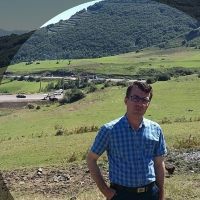Evaluation of the relationship between factors affecting Manning roughness coefficient and estimated water flow velocity in Gharasoo river, Ardabil
The main effect of vegetation in the rivers course is on the flow velocity. The velocity is affected by different vegetation type such as shrub, bush and grass-like in the bed, river side and floodplain. The water velocity at a river channel cross-section tends to decrease, due to the effects of vegetation stems and leaves by the flow resistance. As the flow velocity decreased, the water depths increase, which results the backwater and flooding of the floodplains. The regular and irregular (typical of many natural channels) geometric shape are different cross section types within the reach, which affect the flow characteristics especially during floods. The Manning’s n is a coefficient which characterizes the roughness of the river channel cross section and longitudinal variations. Manning’s n-values are often defined from tables, but can be estimated from field measurements. The selection of a Manning’s roughness coefficient value is depending on the expert judgment and can strongly affect computational results of the river flow velocity and discharge. In the present study, the effect of vegetation cover and the affecting factors of Manning roughness coefficient and flow velocity estimation were investigated. The aim of this work is to study the variation of Manning roughness coefficient (n) with the distance and flow river geometry along a river flowing in a low-lying plain.
In order to conduct this research, the characteristics of the vegetation and water flow velocity were recorded through field survey in 24 cross sections. The study area was a reach of the Qarehsou River, (from Anzab to Poleh Samian locations in a 16.70 km river length). Field measurements of flow velocity and evaluation of Qharahsoo riverbed were performed in May 2016. It should be noted that in the mentioned season, the river flow has a moderate flow that is fed through tributaries that originate from the forest area of Fandolo, Abi Begloo and upstream of Namin. The type and density of vegetation in the studied periods is different and is a combination of shrubs (turmeric), herbaceous plants (grasses, weeds) and in some cases natural trees (willow) or plantation (poplar). In the present study, the effect of vegetation on flow velocity has been evaluated through the instructions in the standard table for estimating vegetation conditions in calculating the roughness coefficient. Then the manning coefficient were estimated using the Cowan method for each river cross-section. Also, the relationship between vegetation related and flow depended variables inter-relationship were tested using Pearson correlation method in the SPSS software.
The values of Manning’s roughness coefficient, n found in this study is in the range of 0.0275 to 0.0831. According to the results, the flow depth had a significantly inverse relationship (r=-0.889, r=-0.934, p<0.01) with the velocity and the channel width. While, a negative significant correlation (r=-0.375, p<0.05) exists between the flow depth and manning roughness coefficient. Also, stream width had a negative correlated with Manning coefficients (r =-0.387, p<0.05), and had a direct relationship with flow velocity (r =0.941 and p<0.01). The value of manning roughness coefficient decrease, the amount of flow velocity, discharge, hydraulic radius, and flow width increases (r=-0.347, r=-0.474, r= -0.412, r=-0.387, with p<0.05 significance level). The variations of n manning roughness is due to changes of the river cross-sections, the flow depth and velocity, and the irregularities of the bed forms which affect the estimated flow velocity.
Also, the results showed that the estimated and measured velocity had an acceptable agreement, which is proved using the Pearson correlation coefficient. The accuracy of the velocity estimation indicates the ability of the Cowan method in manning roughness coefficient estimation and flow velocity. River channel geometry and stream flow characteristics are inter-related in natural channels with irregular condition. Variations in the geometry and vegetation of the river channel can impact stream velocity and resulted discharge estimation. In general, based on the results of the range of computational values, the minimum and maximum Manning roughness coefficients of 0.0275 and 0.0836 show that the values presented in the range are close to the roughness coefficient of natural rivers. It should be noted that the studied Qharahsoor River reaches passes through the agricultural lands of Ardabil plain, so the impact of agricultural land use and human interventions in the destruction of vegetation is evident and is one of the cases that has changed the dynamics of flow and erosion. In many cases, agricultural lands have been plowed along the river, and the removal of vegetation has caused sloping shores and intensified erosion. The relationship between discharge variables and the rate of erosion along the river bank and the bed is one of the items that can be studied in future research. According to the results, Manning's coefficient variations is influenced by the river morphometry and the vegetation characteristics in the cross section of the river. The manning equation in the studied meander river provide reliable results for flow velocity estimation, flood routing and inundation simulation studies.
- حق عضویت دریافتی صرف حمایت از نشریات عضو و نگهداری، تکمیل و توسعه مگیران میشود.
- پرداخت حق اشتراک و دانلود مقالات اجازه بازنشر آن در سایر رسانههای چاپی و دیجیتال را به کاربر نمیدهد.




